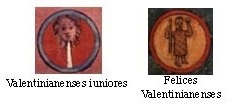Scutum
The late Roman Scutum, or shield, was usually circular or ovoid in shape. Generally speaking, they were dished, although many were flat. Shield bosses at this time were either domed or pointed, as one begins to see the trend towards later button bosses emerge. It is cheaper to make and paint your own shield, but easier to buy one, so it is up to you how you want to go about acquiring your shield.
Shields should be made of plywood 1/4-6/16 inches thick, or should be made of laminated strips glued together in three layers of the same total thickness. They should be covered with linen and edged with rawhide or leather. The leather should be stiched, not riveted on, and the linen can be glued.
For our unit, you must base your paint off of the provided shield patterns from the Notitia Dignitatum, as shown at the top-right of the page. However, feel free to incorporate other elements and make it more decorative, as these patterns were quite simplified ones.
WHERE TO BUY:
Loricatus - Makes nice oval, round, and dished late Roman shields, with custom paint options availible.
Fabricae - French website that sells good shields.
Armillum - Sells blank late Roman round shields.
MAKE YOUR OWN:
Fectio DIY Guide - How to make your own late Roman Scutum.
Comitatus DIY Guide - How to make a planked late Roman Scutum.
HR Replikate - Sells late Roman and migration era shield bosses.
Soul of the Warrior - Sells several Round, Domed shield bosses.
The Spatha was the late Roman longsword, which had replaced the Gladius in the 3rd century AD. It was used by both Roman and Germanics throughout the migration era, and would later become the medieval longsword. The Spatha was usually made with the streifendamast technique, but many were also pattern welded. They typically had a fuller, double fuller, lenticular, or a hexagonal blade. There is one readily available on the market now made by Deepeeka.
WHERE TO BUY:
Soul of the Warrior - Sells the new Deepeeka Germanic Type-I Late Roman Spatha, based off the Feltwell blade and designed by the members of Romanarmytalk and the Magister Militum himself. Highly recommended, and far cheaper than anything else available.
Armae - Sells the new Deepeeka Feltwell Late Roman Spatha. They also have a late 2nd-early 4th century Lauriacum-Hromovka type Spatha, made by Deepeeka.
Hans Binfeld Replicas - Sells a Trier Spatha, Roman, c.a.400 AD. Probably the cheapest one available.
Replik Armory - Sells the Idesheim Spatha, but is very expensive.
Templ Armory - Swords made by Patrick Barta. Very expensive. This one is a Germanic Nydam blade
Templ Armory - Swords made by Patrick Barta. Very expensive. This is a Silver Hilt from Kragenhul.
CUSTOM ORDER - BLACKSMITHS:
Robert Wimmers - More expensive blades, but a more traditional method. Great smith, fair prices, Europe.
Paul Binns - Very high quality, expensive blades, mostly pattern welded. UK Smith.
Semispathae, Seaxes, and Knives
WHERE TO BUY:
Replik Armory - Sells the only Semispatha replica I could find, dated to the mid-3rd century AD. Would be appropriate for 4th century use as well. Very pricey
.Templ Armory - Sells a 5th Century Seax, based on the finds of Pouan and Blucina. This is often associated with the Battle of Chalons, but that is still conjecture. Very pricey.
CUSTOM ORDER - BLACKSMITHS:
Robert Wimmers - More expensive blades, but a more traditional method. Great smith, fair prices, Europe.


